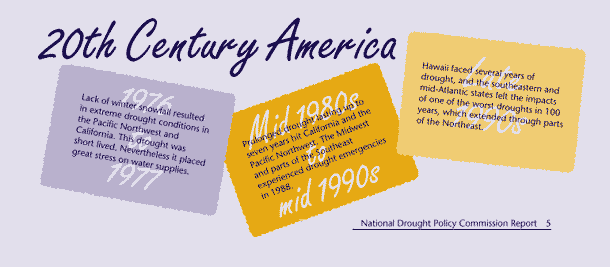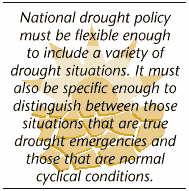|
|
| Return to Table of Contents |
|
Because of the extremely diverse climates, topographies, watersheds, water sources, and water uses within this country, we find it impractical to define specific drought thresholds that could act as triggers for drought actions for various parts of the country. However, we recognize that a suite of objective triggers similar to those used by the Australian Drought Policy Review Task Force has the advantage of taking much of the politics out of drought-response decisions. As in Australia, these should be both supply-type triggers, reflecting moisture deficiencies caused by acts of nature (lack of rain, excessive temperatures), as well as demand-type triggers reflecting drought impacts. Examples of current supply-type triggers used in general to define drought or trigger actions related to potential drought include: precipitation less than 60% of normal for the season or present water year (used by the National Weather Service’s Western Region); precipitation less than 85% of normal over the past six months (used by the National Weather Service’s Eastern Region); the Palmer Drought Index -2.0 or less; and consolidated drought indices at the 20th percentile or less (used by the Drought Monitor). For federal action, more rigid triggers such as 5th percentile drought might be appropriate, reflecting truly unusual circumstances. Examples of demand (impact) based triggers include water supply less than 60% of normal (used by the National Weather Service’s Western Region) and various crop loss thresholds used by the U.S. Department of Agriculture. "Stored Water"
and We note that the United
States experiences two types of drought. "Stored water" droughts
occur when large stores of water in man-made reservoirs, natural lakes,
and groundwater aquifers are depleted by very long, unusually low periods
of precipitation. "Natural water" droughts happen |
 |
|
|

